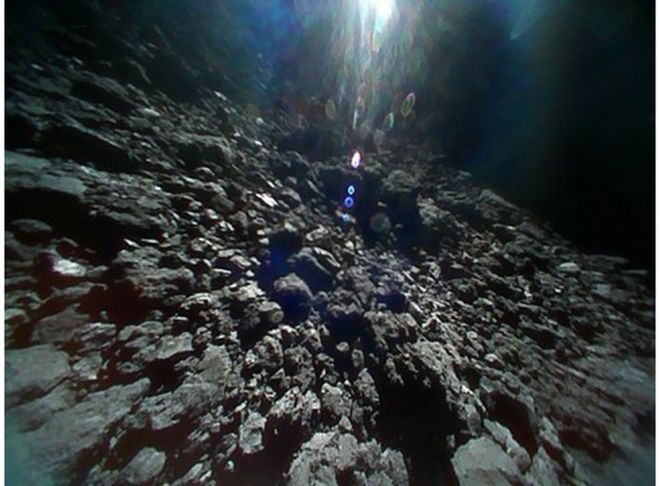
A lot of space news over the past week or so.
1. Asteroid rocks
The big news has been the successful touchdown of landers by the Japanese Hayabusa 2 probe, with three out of four now successfully on the asteroid Ryugu.
The first images are quite extraordinary: New asteroid rover images released
and a short animated GIF shows Ryugu's rotation:
Now the French-German lander (no.3) is on Ryugu, and has already transmitted images from the landing process: Touchdown! Japan space probe lands new robot on asteroid
2. Comets rock, too
A new composite image of Comet 67P/Churyumov-Gerasimenko (67P/C-G), taken by the ESA's Rosetta mission, has been released: Image: Comet landscape

3. TESS finds first exoplanet
The Transiting Exoplanet Survey Satellite (TESS) was launched earlier this year - its mission, to find thousands of undiscovered planets around other stars. Although it's still only in its warming-up stages, it's still managed to find its first exoplanet: NASA’s new exoplanet-hunter has spotted its first alien worlds
Expect many more to come.
TESS succeeds the Kepler telescope, which launched in 2009 and was originally intended to run for 3-5 years. Although it suffered technical failures after that period, it's still managed to continue observations - and has recorded over 2,300 exoplanets. However, Kepler is now almost out of fuel, so scientists are rushing to download what might be its very last set of data: Kepler put into sleep mode as telescope's pointing performance degrades
4. Space bad for guts
I've already posted a recent link to health issues that can effect astronauts due to zero gravity - but cosmic radiation continues to be an additional danger. The most recent study into this suggests that human intestines may be especially vulnerable to damage - and tumours: Animal study suggests deep space travel may significantly damage GI function in astronauts
5. New neighbours found
We already know there are around 150 dwarf galaxies in orbit around the Milky Way - now another four look about to be added: Four newly discovered Milky Way neighbors
These are tiny galaxies - some with just over 1,000 stars - and very faint, hence why they have been hard to detect - and why others might also be out there.
I also can't help wondering what sort of view anyone in them might get of the Milky Way.
In the meantime, we still don't actually know how large our galaxy is - but we may be getting closer to an answer: Narrowing down the mass of the Milky Way
6. Planet 9 from Outer Space
We may have an even closer neighbour, as a recently discovered icy moonlet in the Oort Cloud shows the same clear influence of an unseen planet on its gravity: A newly discovered *extremely* distant icy world points to Planet 9

What's slightly disappointing is that Phil Plait credits the idea of Planet 9 being only very recent - has everyone really forgotten the Nemesis Hypothesis already?
7. Stars zoom in on galaxy
We know there are a number of speeding stars around our galaxy - so-called hypervelocity stars. Data from the GAIA observatory has allowed scientists to identify more, with the surprising discovery that rather than being flung from the Milky Way, most are actually rushing in toward it: Gaia spots stars flying between galaxies

It is possible that these intergalactic interlopers come from the Large Magellanic Cloud, a relatively small galaxy orbiting the Milky Way, or they may originate from a galaxy even further afield. ... An alternative explanation is that the newly identified sprinting stars could be native to our galaxy's halo, accelerated and pushed inwards through interactions with one of the dwarf galaxies that fell towards the Milky Way during its build-up history.
BONUS! Did you know you are walking around with your own mini-biome of bacteria, funghi, and chemicals? If you didn't, recently published research shows just how diverse - and individual - it can be: We are bombarded by thousands of diverse species and chemicals, study finds
Last edited:

